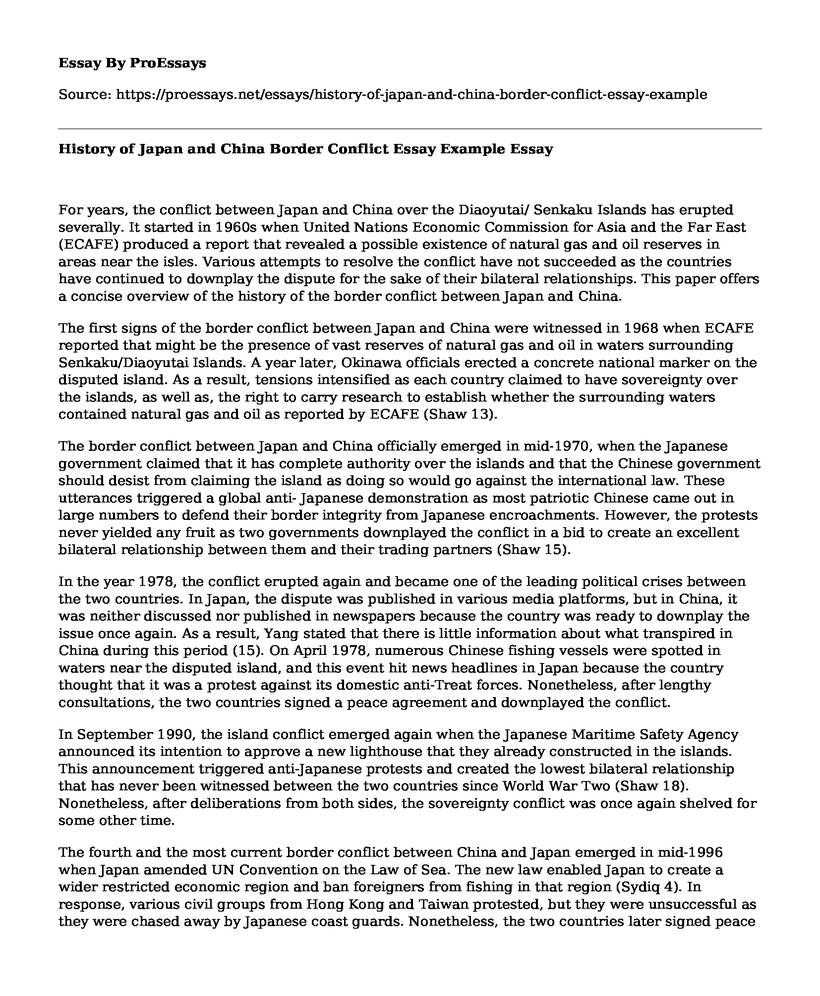For years, the conflict between Japan and China over the Diaoyutai/ Senkaku Islands has erupted severally. It started in 1960s when United Nations Economic Commission for Asia and the Far East (ECAFE) produced a report that revealed a possible existence of natural gas and oil reserves in areas near the isles. Various attempts to resolve the conflict have not succeeded as the countries have continued to downplay the dispute for the sake of their bilateral relationships. This paper offers a concise overview of the history of the border conflict between Japan and China.
The first signs of the border conflict between Japan and China were witnessed in 1968 when ECAFE reported that might be the presence of vast reserves of natural gas and oil in waters surrounding Senkaku/Diaoyutai Islands. A year later, Okinawa officials erected a concrete national marker on the disputed island. As a result, tensions intensified as each country claimed to have sovereignty over the islands, as well as, the right to carry research to establish whether the surrounding waters contained natural gas and oil as reported by ECAFE (Shaw 13).
The border conflict between Japan and China officially emerged in mid-1970, when the Japanese government claimed that it has complete authority over the islands and that the Chinese government should desist from claiming the island as doing so would go against the international law. These utterances triggered a global anti- Japanese demonstration as most patriotic Chinese came out in large numbers to defend their border integrity from Japanese encroachments. However, the protests never yielded any fruit as two governments downplayed the conflict in a bid to create an excellent bilateral relationship between them and their trading partners (Shaw 15).
In the year 1978, the conflict erupted again and became one of the leading political crises between the two countries. In Japan, the dispute was published in various media platforms, but in China, it was neither discussed nor published in newspapers because the country was ready to downplay the issue once again. As a result, Yang stated that there is little information about what transpired in China during this period (15). On April 1978, numerous Chinese fishing vessels were spotted in waters near the disputed island, and this event hit news headlines in Japan because the country thought that it was a protest against its domestic anti-Treat forces. Nonetheless, after lengthy consultations, the two countries signed a peace agreement and downplayed the conflict.
In September 1990, the island conflict emerged again when the Japanese Maritime Safety Agency announced its intention to approve a new lighthouse that they already constructed in the islands. This announcement triggered anti-Japanese protests and created the lowest bilateral relationship that has never been witnessed between the two countries since World War Two (Shaw 18). Nonetheless, after deliberations from both sides, the sovereignty conflict was once again shelved for some other time.
The fourth and the most current border conflict between China and Japan emerged in mid-1996 when Japan amended UN Convention on the Law of Sea. The new law enabled Japan to create a wider restricted economic region and ban foreigners from fishing in that region (Sydiq 4). In response, various civil groups from Hong Kong and Taiwan protested, but they were unsuccessful as they were chased away by Japanese coast guards. Nonetheless, the two countries later signed peace agreements.
Conclusion
Reportedly, following the signing of peace treaties, many civil and political groups from the two countries have continued to visit the disputed island to protest the sovereignty over the islands. Current reports indicate that the two governments continue to downplay the conflict. Intuitively, although numerous initiatives have been taken to avoid further disputes, Shaw noted that based on the history of the battle, the two countries would to continue experience heightened dispute over the islands until such a time they will solve the conflict (21).
Works Cited
Shaw, Han-yi. "Diaoyutai/Senkaku Islands Dispute: Its History and an Analysis of the Ownership Claims of the PRC, ROC, and Japan." Occasional Papers/Reprint Series in Contemporary Asian Stud, 1999, pp. 5-127.
Yang, H. C. "China, and Japan's Dispute over the Senkaku/Diaoyu Islands." Marine Policy, vol. 1 no. 2, 2012, pp. 14-15.
Sydiq, Tareq. "Competing for the Sea: Historical origins of the territorial dispute over the Senkaku/Diaoyu islands." Philips University of Marburg, 2015, pp. 2-9.
Cite this page
History of Japan and China Border Conflict Essay Example. (2022, Nov 20). Retrieved from https://proessays.net/essays/history-of-japan-and-china-border-conflict-essay-example
If you are the original author of this essay and no longer wish to have it published on the ProEssays website, please click below to request its removal:
- The Visible Hand - Literary Analysis Essay
- Criminology and Domestic Violence in UK Essay Example
- Essay Example on Esmarch: From Tonning to Military Surgeon
- Essay Sample on Japan's Rise of Militarism
- Essay Sample on Alexander Hamilton: Orphan to Right-Hand Man
- Legislature, Redistricting, and Population Disparities in US - Essay Sample
- West vs East: Understanding Facial Emotions in Social Contexts Essay







